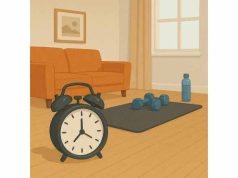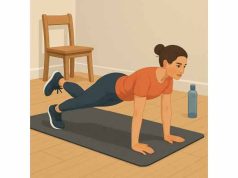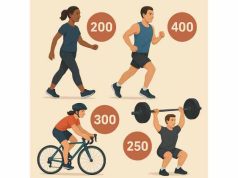
Rest days are not “lost” days when you are trying to lose weight—they are how you protect muscle, keep hormones steady, and show up for the next workout with intensity. The right number depends on your training age, weekly volume, job stress, sleep, and the size of your calorie deficit. This guide turns those moving parts into clear rules you can apply today. You will find sample schedules for two to six training days, how to use “active recovery” without sabotaging rest, and practical signs you need more (or fewer) days off. For a bigger picture of how strength, cardio, and daily steps work together, see our concise overview of effective exercise for fat loss and then map your rest days to that framework.
Table of Contents
- How many rest days?
- Recovery signs and metrics
- Weekly templates by goal
- Cardio on rest days?
- Strength split and rest spacing
- Special cases and modifications
- Troubleshooting and deloads
- Frequently Asked Questions
How many rest days?
There is no single “fat-loss number.” Most adults make their best progress with 2–4 rest days per week, depending on how hard they train and how aggressively they diet. Here is how to decide:
1) Start from your weekly strength target.
Preserving muscle while losing fat is priority one. Two to three full-body strength sessions or a four-day upper/lower split covers most needs. Higher strength frequency demands more rest days so you can lift hard when it counts.
2) Layer in cardio minutes—then re-check recovery.
Aim for 150–300+ minutes weekly across steady cardio and steps. If you add one HIIT session (10–20 minutes of hard intervals), you will likely need one additional easy day or a lighter lift to balance fatigue.
3) Match rest to training age.
- Beginner: 3–4 training days + 3–4 rest days. Your nervous system and connective tissue need more off-days while technique improves.
- Intermediate: 4–5 training days + 2–3 rest days. Rotate hard/easy.
- Advanced: 5–6 training days + 1–2 rest days, only if sleep, nutrition, and stress are dialed in.
4) Let your calorie deficit set the ceiling.
The larger the deficit, the fewer intensely stressful sessions you can recover from. In a modest 300–500 kcal/day deficit, most people do well with two to three strength days, one interval day, and one to two steady-state days—leaving two rest days. During aggressive mini-cuts, shift to three rest days and reduce HIIT.
5) Define “rest day” correctly.
Rest does not mean inactivity. It means no heavy loading or breathless work. Keep steps (6,000–10,000+) and gentle mobility to support recovery without adding stress.
Practical ranges
- 2 rest days: You lift 3–4×/week, run one easy cardio day, maybe one short HIIT. Sleep and stress are stable.
- 3 rest days: You lift 2–3×/week, add 1–2 cardio days. Useful when work is demanding, you are new to training, or you are dieting more aggressively.
- 4 rest days: You lift 2×/week plus 1 low-intensity cardio day. Ideal for beginners, older trainees returning from a layoff, or anyone with high life stress.
If you are new to structured training or rebuilding habits, anchor the big rocks first: resistance training, walking, and a consistent calorie target. For the fundamentals behind safe rates of loss, macros, and weekly planning, skim our straightforward guide to weight-loss basics and then return to choose your rest cadence.
Recovery signs and metrics
Your best rest schedule is the one that lets you progress—add reps, load, or pace—while feeling human. Use this checklist weekly to fine-tune how many days off you need.
Performance markers
- Bar speed and reps: If your final sets grind sooner than usual for two consecutive sessions, add a rest day or lower volume by ~20% for a week.
- Cardio quality: Interval power or pace drops sharply (>5–8%) at the same perceived effort—pull back.
- Warm-up feel: If you need twice the ramp time to feel coordinated, you are carrying fatigue.
Physiological cues
- Sleep: Trouble falling or staying asleep, or waking unrefreshed, often precedes plateaus.
- Resting tension: Persistent muscle tightness or “heavy legs” on stairs flags under-recovery.
- Appetite shifts: Unusual cravings plus irritability can signal stress load, not just willpower.
Behavioral and mood cues
- Motivation dip: Dreading sessions you previously enjoyed is a reliable early warning.
- Decision fatigue: Nutrition adherence unravels late day; you snack to self-medicate fatigue.
Simple trackers (no gadgets required)
- RPE diary: Rate each session’s overall difficulty (1–10). If average RPE climbs while output falls, you need more rest.
- Checkpoints: Each Sunday, score sleep, stress, soreness, and mood from 1–5. An average of ≤3 suggests holding or adding a rest day.
How to adjust
- One bad day: Keep plan, extend warm-up, cut last set.
- Two to three bad days: Add one rest day this week and reduce accessory volume.
- A full week of drag: Take a deload (see Troubleshooting) or shift one HIIT to steady state.
Recovery is not just time off; it is what you do between sessions. On rest days, use 15–20 minutes of easy mobility and walking to increase circulation and reduce soreness. For practical drills and sequencing, see our primer on warm-up, mobility, and recovery.
Weekly templates by goal
Use these plug-and-play schedules. Each template lists training, cardio, and rest days, plus where to put steps and mobility. Swap days to match your calendar; preserve the hard/easy alternation.
Template A — Beginner fat loss (3 training days, 3 rest, 1 easy cardio)
- Mon: Full-body strength (45–60 min)
- Tue: Rest + 7,000–10,000 steps + 10–15 min mobility
- Wed: Full-body strength
- Thu: Rest + 25–35 min steady walk or bike
- Fri: Full-body strength
- Sat: Rest + long walk (45–60 min, easy)
- Sun: Rest
Why it works: frequent skill practice without back-to-back heavy days. Expect 2–3% monthly strength gains while dieting.
Template B — Time-pressed (2 strength, 2 cardio, 3 rest)
- Mon: Strength (full-body)
- Tue: Rest + steps
- Wed: Intervals 15–20 min inside a 25–30 min session (bike or elliptical)
- Thu: Rest
- Fri: Strength (full-body)
- Sat: Steady cardio 30–45 min (walk, cycle)
- Sun: Rest
Why it works: you keep intensity quality high and appetite stable.
Template C — Intermediate (3 strength, 2 cardio, 2 rest)
- Mon: Lower strength + 10 min easy spin
- Tue: Upper strength
- Wed: Rest + mobility
- Thu: HIIT 20–25 min (short intervals)
- Fri: Full-body strength (lighter)
- Sat: Steady cardio 35–50 min
- Sun: Rest
Why it works: strategic spacing of heavy legs and HIIT protects performance.
Template D — Upper/Lower split (4 strength, 2 rest, optional easy day)
- Mon: Upper
- Tue: Lower
- Wed: Rest or 30 min Zone 2
- Thu: Upper
- Fri: Lower
- Sat: Rest + long walk
- Sun: Optional easy ride 30–40 min
Why it works: higher frequency with built-in spacing and flexible easy work.
Want help selecting exercises and set-rep targets for a three-day plan? Our simple beginner strength blueprint pairs perfectly with Templates A–C.
Progressing the week
- Add one set to a big lift, or 5 minutes to steady cardio—not both in the same week.
- Cap weekly HIIT at two sessions unless you reduce lifting volume.
Cardio on rest days?
Short answer: yes—if it is truly easy. Active recovery can speed restoration without stealing resources from your next lift. The key is intensity.
What “easy” means
- You can breathe through your nose or hold a full conversation.
- Heart rate stays in an easy aerobic range (often called Zone 2).
- You finish feeling better than you started.
Good options (20–45 minutes): brisk walking (outdoors or incline treadmill), relaxed cycling, elliptical with light resistance, gentle rowing (technique focus), or an unhurried hike. Combine with 5–10 minutes of mobility for hips, T-spine, and ankles.
What to avoid on rest days
- Long runs you have not built up to, jump-heavy circuits, or “as many rounds as possible” sessions.
- Hill sprints, plyos, or anything that leaves your legs rubbery.
How to dose
- Beginners: 2–3 active recovery sessions/week at 20–30 minutes.
- Intermediates: 1–2 sessions at 30–45 minutes.
- Busy weeks: Replace one interval day with an easy recovery session.
Why it helps fat loss
Easy movement increases weekly energy use, stabilizes appetite, and reduces soreness so you can lift hard on training days. It also supports mitochondrial adaptations that make future workouts feel easier at the same pace. For a clear explanation of targets and sample sessions, see our guide to easy Zone 2 cardio.
Strength split and rest spacing
Rest days are most valuable when they sit between your most stressful sessions. Use these placement rules to keep strength quality high while dieting.
Full-body frequency (2–3×/week)
- Place rest or easy cardio between sessions (e.g., Mon lift, Tue rest, Wed lift).
- If you must lift on back-to-back days, make day two lighter (tempo work, machines, fewer sets).
Upper/Lower split (4×/week)
- Sequence Upper → Lower → Rest → Upper → Lower → Rest to avoid compounding leg stress.
- If soreness lingers, move Lower day 2 to Sunday and keep Saturday entirely off.
Concurrent cardio
- Prefer post-lift steady cardio (10–20 minutes) to avoid a separate session.
- Do HIIT on a separate day from heavy lower-body lifting, or at least separate by 6–8 hours, with HIIT first only if you are chasing cardio performance specifically.
Volume and intensity while dieting
- Keep heavy sets in the 3–6 rep range for big lifts, and moderate sets (8–12 reps) for accessories.
- Maintain load; trim sets first if recovery slips.
- Avoid chasing rep PRs during aggressive deficits; focus on maintenance with excellent form.
If you are unsure which exercises give the best “return on fatigue,” our overview of smart exercise choices for fat loss prioritizes movements that preserve muscle without burying recovery.
Special cases and modifications
Your ideal number of rest days moves with life stages, training age, and constraints. Use these adjustment notes to personalize the plan.
Beginners or returning after a layoff
- Choose 3–4 rest days. Start with two full-body lifts and one easy cardio day. Progress volume slowly (add 1 set or 5 minutes per week).
Older adults (50+)
- Favor 3 rest days with more low-impact cardio and longer warm-ups. Prioritize power and balance drills early in the session (e.g., step-ups, light med-ball throws) before heavy work.
High-stress weeks or poor sleep
- Trade one interval session for an easy 30–40 minute walk. Shrink accessory volume by 20–30%. Keep protein high and bedtime consistent.
Menstrual cycle considerations
- Late luteal phase: plan an extra rest day or lighter loads. Follicular phase: most can push intensity. Keep steady cardio consistent throughout for mood and energy.
Joint pain or high body mass
- Go low impact and add rest days as needed. Use bike, elliptical, or incline walking; avoid deep knee flexion until strength builds. Our overview of joint-friendly cardio outlines options and progressions.
Endurance athletes cutting body fat
- Maintain critical long sessions but reduce intensity mid-week. Keep at least two rest/active recovery days. Lift twice weekly with 2–3 sets of key patterns to hold muscle.
Shift workers
- Anchor rest days after night shifts. Keep sessions short (30–45 minutes) and technique-focused. Hydrate and nap before lifting when possible.
Troubleshooting and deloads
Even well-planned weeks can stall. Use this decision tree when progress slows or fatigue accumulates.
Plateau checklist (run in order):
- Adherence: Are you hitting protein and calorie targets ≥80% of the week? If not, hold training volume; fix meals and sleep first.
- Steps: Is your step count drifting down? Add 1,000–2,000 daily steps before adding workouts.
- Session quality: If bar speed or interval pace is sliding, add a rest day this week and cut accessory sets by 25% for 7–10 days.
- Intensity drift: Are “easy” sessions creeping hard? Recalibrate with nose-breathing and conversational checks.
- Swap HIIT → steady: Replace one interval day with 35–45 minutes easy cardio for two weeks; reassess appetite, energy, and strength.
Deload every 4–6 weeks (or sooner if needed)
- Strength: reduce sets by 30–40%, keep load at 80–90% of usual; focus on form and speed.
- Cardio: drop intervals entirely; keep two to three easy sessions of 25–40 minutes.
- Lifestyle: extend sleep, elevate steps, and emphasize mobility.
When to see a clinician
- New sharp pain, chest discomfort, unusual shortness of breath, dizziness, or persistent swelling. Clear red flags before resuming training.
Keep a simple weekly log of training, steps, sleep, and mood. Small, consistent adjustments—often one more rest day, a swap to easier cardio, or a modest volume cut—restore momentum without derailing your plan. If you prefer to raise daily burn without extra workouts, build in more movement outside the gym; our primer on NEAT strategies shows how to do that efficiently.
Frequently Asked Questions
What is the ideal number of rest days for fat loss?
Most people progress best with two to three rest days weekly. Beginners and those in larger calorie deficits often need three to four. Choose the minimum that keeps strength quality high, appetite manageable, and energy stable across the week.
Can I do cardio on a rest day?
Yes—keep it easy. Use brisk walking, light cycling, or gentle elliptical for 20–45 minutes at conversational pace. You should finish feeling fresher, not depleted. Save intervals or hard hills for training days to protect recovery and strength performance.
Do rest days slow down weight loss?
No. Rest days protect muscle, stabilize hormones, and improve workout quality, which supports long-term fat loss. Maintain steps and light movement on rest days to keep weekly energy expenditure up without adding fatigue.
How do I know I need an extra rest day?
Watch for slower bar speed, dropping interval pace, poor sleep, irritability, heavy legs, or rising session RPE despite lower output. If two to three sessions in a row feel off, add a rest day and trim accessory volume by 20–30% for a week.
Where should I place rest days in my week?
Put them after your most stressful sessions—heavy lower-body days, long runs, or HIIT. For upper/lower splits, a common pattern is Upper → Lower → Rest → Upper → Lower → Rest. For full-body plans, alternate lift days with rest or easy cardio.
Is active recovery the same as a workout?
No. Active recovery is deliberately light. You should breathe easily, move smoothly, and finish feeling better than you started. If your “recovery” session leaves you sore or breathless, it was a workout—dial it back next time.
How often should I deload during a cut?
Every four to six weeks for most, or sooner if fatigue accumulates. Reduce sets by ~30–40%, skip intervals, and keep two to three easy cardio sessions. Resume normal training once sleep, mood, and performance rebound.
References
- Physical activity 2024 (Guideline)
- Lean mass sparing in resistance-trained athletes during caloric restriction: the role of resistance training volume 2022 (Systematic Review)
- The Effect of High-Intensity Interval Training Type on Body Fat Percentage, Fat and Fat-Free Mass: A Systematic Review and Meta-Analysis of Randomized Clinical Trials 2023 (Systematic Review & Meta-analysis)
- Concurrent Strength and Endurance Training: A Systematic Review and Meta-Analysis on the Impact of Sex and Training Status 2024 (Systematic Review & Meta-analysis)
- WHO guidelines on physical activity and sedentary behaviour: at a glance 2021 (Guideline)
Medical Disclaimer
This guide is educational and not a substitute for personalized medical advice. Consult a qualified professional before changing exercise or nutrition—especially if you have cardiovascular, metabolic, or orthopedic conditions; take medications that affect heart rate or blood glucose; are pregnant or postpartum; or are returning after injury or surgery.
Share and Stay Connected
If this guide helped you plan smarter rest days, please share it with someone who would benefit and consider following us on your preferred social platforms. Your support helps us continue producing clear, evidence-informed resources.










